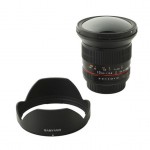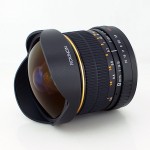If I get a new camera system I’ll need new lenses. I’m looking carefully at the Sony NEX E-Mount and Fujifilm X-mount because they offer fairly compact cameras with large, APS-C sized sensors. On top of that, however, I usually like to shoot a very wide-angle lens.
On a Sony NEX, my best choice might be Sony’s 10-18mm SEL-1018. That’s 15mm after the 1.5x crop factor, and that’s just fine. On the downside, it’s an $850 lens, and only has an F4 maximum aperture.
The story from Fujifilm is even worse, however. Their widest lens is a 14mm prime, which is 21mm after the 1.5x crop. Carl Zeiss offers a 12mm lens, but you’ll pay dearly for those few extra millimeters.
My lens choices are limited by my insistence on autofocus for my every day lens, but if I either relax my wide-angle ambitions or give up on autofocus, I’ll have a lot more options.
Wide lenses are usually also big lenses, it’s worth considering what compact lenses are available. Fujifilm offers a tiny 27mm F2.8 prime and Sony offers a similarly small 16mm F2.8 prime as well. Again, with 1.5x crops, these are 40mm and 24mm equivalent. If I treat a lens like that as the general use, walking around, everyday lens for the camera, perhaps there’s a manual focus super-wide wide-angle to use for timelapsing?
Samyang (the .pl site is prettier) announced a 10mm F2.8 rectilinear prime, but then announced its release is delayed via Facebook. That would have been an ideal lens, and still might be if it’s released. Unfortunately, that’s the only super-wide rectilinear lens in this space. There’s a good selection of fisheyes and fast primes that are interesting.
Still, the manual lens space is worth considering. I’d never dared going back to manual focus with my old Canon Rebel, but live view and focus peaking make it an intriguing option. Focus peaking is available on Sony NEX, and with a recent firmware update on Fujifilm X cameras.
In fact, here a number of lens manufacturers I’ve heard of, but completely ignored because the didn’t make sense in my old world:
- Noktor, 50mm F0.95 review
- Opteka, 500mm F8 reviews
- Rokinon, 8mm F2.5 fisheye review
- Samyang, 10mm F2.8 prime announced, but delayed
- SLR Magic, 23mm F1.5 review
- Voigtländer, 50mm F1.1 review
A cheap fisheye is interesting to me, and it’s a possible stop-gap while I wait for other lenses to come to market, especially with the use of image processing software to straighten out the lines.
I might as well also consider a mount converter so I can potentially use a broader variety of new and used glass. Nikon F mount lenses are praised for being easy to use in completely manual systems, and Metabones has adapters for both Sony NEX and Fujifilm X mounts for $99, but other brands have then as low as $20.
There are also some more typical third-party lens makers to consider:
Images from manufacturer’s websites:

